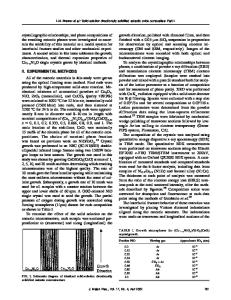Silicon-Silicide Eutectic Composites
- PDF / 4,330,123 Bytes
- 12 Pages / 414.72 x 648 pts Page_size
- 106 Downloads / 402 Views
ABSTRACT Many silicides, including TaSi 2 , CoSi 2 , TiSi 2 and others, form eutectics with silicon. Directional solidification of melts with the eutectic composition and controlled doping of the silicon matrix results in two-phase electronic composites with oriented structures. Such composites have unusual microstructures and interesting properties resulting from the high density of Schottky junctions. In this paper, the growth, microstructure, transport properties and device applications of silicon-silicide composites are reviewed, concentrating mostly on the benchmark Si-TaSi 2 system. The Si-TaSi 2 interface, formed upon solidification, is characterized electrically as well as structurally by electron-beam induced current techniques, x-ray diffraction and high resolution TEM. It is shown that the interface is of remarkably good quality allowing the fabrication of very high quantum efficiency (80%) photodiodes and high voltage (up to 6kV) transistors.
INTRODUCTLON Metallic refractory silicides have become technologically important materials because of their high conductivity and stability. Many disilicides, in particular, are thermodynamically stable relative to Si because they form a eutectic with Si. Such silicides include those of Ta, W, Co, Zr, Cr, and Ti. The eutectic phase diagrams, which describe the equilibrium phase concentrations of Si and these disilicides as a function of composition, also provides for a novel way of preparing composites of these materials, that is, by directional solidification of the eutectic composition. This paper reviews the accomplishments of a 10 year long research program, conducted at GTE Laboratories, Incorporated that sought to develop a totally new electronic composite material using this approach. The material, which we have generally come to refer to as SME for semiconductor-metal eutectic, is a composite with a high density of aligned metallic rods embedded in a matrix of a semiconductor. On the one hand the material differs dramatically from silicon, the host material used to fabricate almost all conventional electronic devices. Silicon is a pure, single-phase material, while SME's like the silicon-tantalum disilicide system are two-phase equilibrium structures. In silicon, devices are made by the controlled doping of surface layers to form junctions that enable switching. In SME materials the basic junctions needed for switching and electronic control are grown-in and are therefore, contained throughout the materials bulk. With the example of the Si-TaSi 2 system, there is a Schottky junction between the n-type Si matrix and the TaSi 2 rod. On the other hand, there are obvious similarities between the two electronic materials and it is possible that studies of the structure of the silicon matrix and characterization of the silicon-silicide interface that have been performed during the development of this novel electronic material, could be of interest to members of the scientific
435 Mat. Res. Soc. Symp. Proc. Vol. 320. @1994 Materials Research Society
community
Data Loading...











